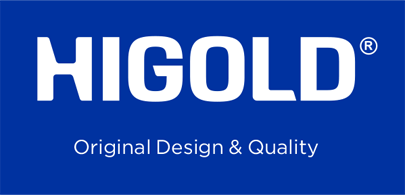The kitchen faucet is one of the indispensable basic facilities in every kitchen. It not only undertakes the basic functions of providing water, washing ingredients and tableware, but also determines the convenience and comfort of kitchen operation to a certain extent. The extension position of the faucet, that is, the distance between the water outlet and the kitchen sink, is also an important consideration when choosing a faucet.
Many people may ignore this point and think that the extension distance of the faucet is irrelevant, but in fact, the distance between the faucet and the sink has a direct impact on the kitchen experience.
If the kitchen faucet extends too short or too long, it will affect the daily operating comfort, cleaning convenience and functionality of the sink. This article will analyze the appropriate distance of the faucet extending to the sink from multiple angles to help consumers make reasonable choices based on the actual needs of their kitchens.
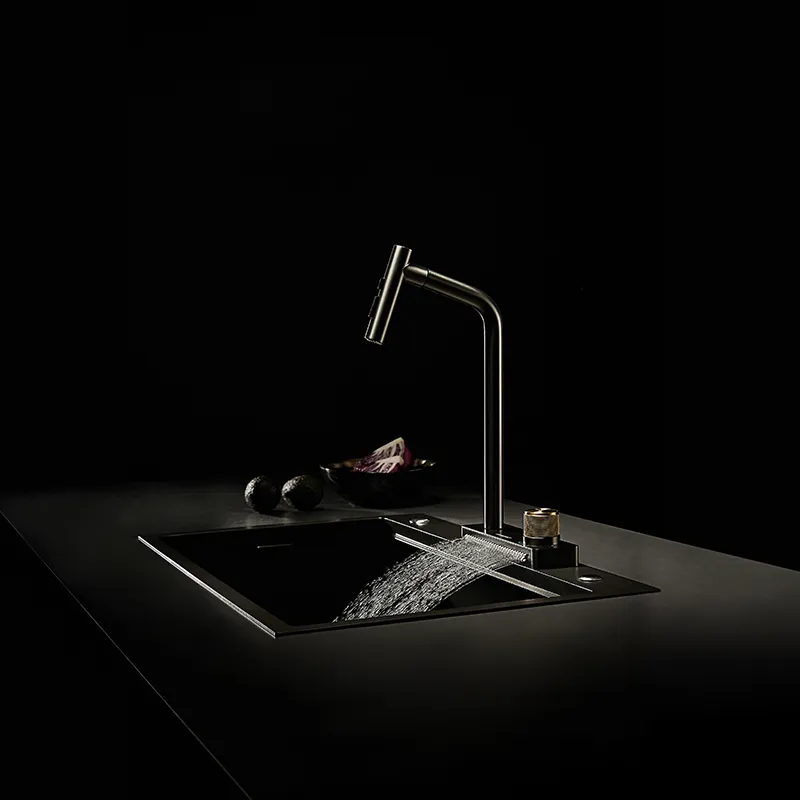
Why is the extension distance of the kitchen faucet important?
The appropriate extension distance can not only improve the efficiency of the water flow, but also optimize the use space of the sink and avoid splashing, leakage and other problems. A kitchen faucet that is too short or too long may cause the following problems:
·Water splashes out of the sink: If the faucet outlet is too far from the sink, water is prone to splashing when it flows into the kitchen sink, especially strong water flow may splash water, wet the kitchen countertop, and increase the difficulty of cleaning.
·Inconvenient operation: If the faucet extension distance is too short, it may affect the use space of the kitchen sink, especially when washing large tableware, vegetables and fruits, the water flow may not fully cover all corners, causing water flow inconvenience and increasing the difficulty of operation.
·Waste of water resources: If the faucet extends too long, it will cause water waste, because the water flow is too long, and the design of the faucet may cause unstable water flow, resulting in uneven water flow, which is easy to cause water waste.
·Affecting aesthetics: The matching degree of the faucet and the sink will directly affect the overall aesthetics of the kitchen. If the design and extension distance of the faucet are not coordinated with the sink, it may destroy the overall visual effect of the kitchen.
Therefore, finding a suitable extension distance for the kitchen faucet can not only improve the work efficiency of the kitchen, but also optimize the use of space and enhance the overall aesthetics of the kitchen.
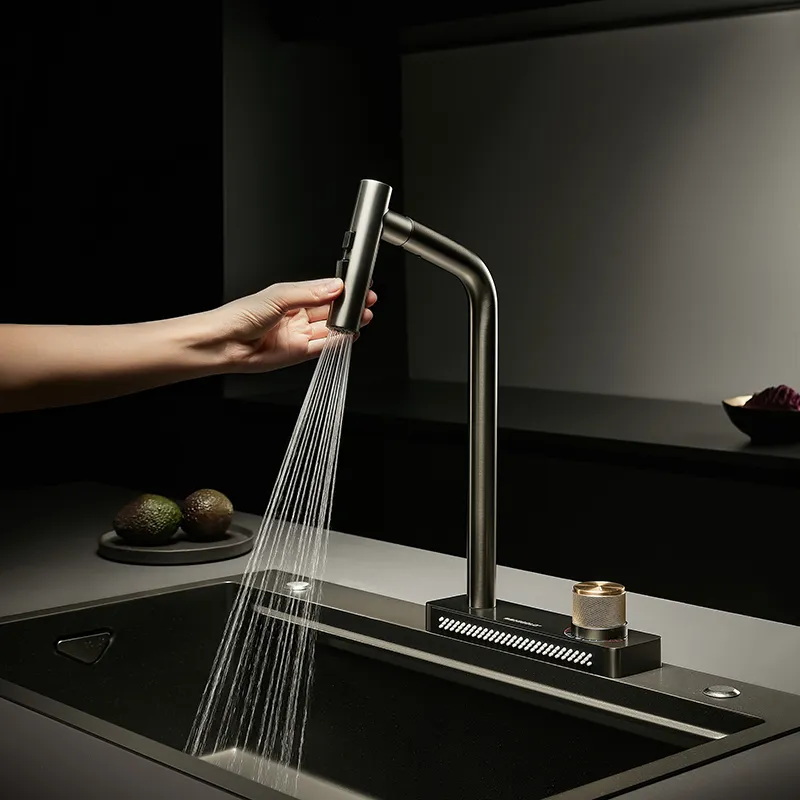
What is the standard extension distance of the kitchen faucet?
Based on years of kitchen design experience and user feedback, there is no absolute standard for the optimal extension distance between the kitchen faucet and the sink, but it should be determined based on multiple factors such as the type, size, shape of the sink and personal usage habits. However, there are some common standards and suggestions that can be used as a reference to help consumers make reasonable choices.
1. Standard extension distance of conventional sinks
For standard-sized single-bowl sinks (usually about 50-80 cm long and 30-40 cm wide), the extension distance of the faucet should be 10-15 cm from the edge of the sink. This distance ensures that the water flows smoothly into the sink without causing splashes. Generally speaking, an extension distance of 10 cm is ideal, which can provide sufficient operating space and avoid splashing problems caused by excessive water flow.
For double-bowl sinks, the extension distance of the kitchen faucet is also recommended to be between 10-15 cm. If the notches on both sides of the sink are deep, proper extension can make it easier for the water flow to cover every corner of the sink. For families who need to frequently wash large dishes or pots, an extension distance of about 15 cm can provide better operating space.
2. Extension distance of deep sinks
If your kitchen uses a deep sink (deeper than 20 cm), the extension distance of the kitchen faucet can be appropriately increased. For deep sinks, the extension distance of the faucet is generally recommended to be 15-20 cm. This distance helps to prevent water from splashing out of the sink, while also providing enough space for washing large items.
However, when choosing a deep sink, the height of the faucet is also very critical. If the depth of the sink is very deep, the height and extension distance of the faucet need to match to ensure that the water can enter the sink smoothly without splashing.
3. Extended distance for large and wide sinks
For large sinks (e.g., sinks over 120 cm long and 40 cm wide), or wide sink designs (e.g., wide double sinks), the extended distance of the faucet should be kept at more than 15 cm. For this type of sink, the design of the faucet not only needs to consider the extended distance, but also needs to ensure that it can adapt to a wide range of water flow to wash large items such as large pots and baking trays.
At this time, the stretch function or rotation design of the kitchen faucet will become a very important consideration. Through the stretch function, the faucet can better cover all corners of the sink, especially when large items need to be washed, the extended faucet can greatly improve the convenience of use.
4. Special design sinks (such as asymmetrical sinks)
If your sink design is very special, such as an asymmetrical shape or a special corner sink design, the extended distance of the faucet also needs to be determined according to the specific layout of the sink. In this case, the extended distance of the faucet may require more customized design, especially to ensure that the water flow can cover all the use areas of the sink to avoid unnecessary water waste.
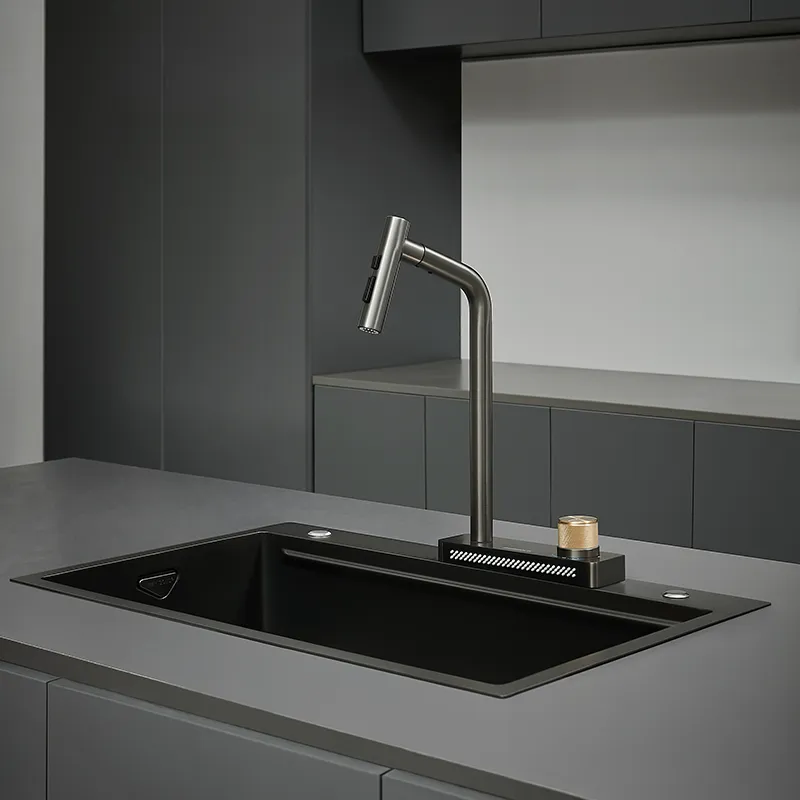
How to choose a suitable kitchen faucet?
Although the extension distance of a kitchen faucet is closely related to the size and type of the sink, choosing a suitable faucet also requires comprehensive consideration of its other functions and designs. For example, the stretching function, rotation function, water outlet method and installation method of the kitchen faucet directly affect the practicality and comfort of the faucet.
1. Stretching function
If you often need to wash large tableware, pots or deep sinks, a faucet with a stretching function may be the best choice. The stretching faucet can flexibly extend the water pipe to cover various areas of the sink, avoiding the inconvenience caused by insufficient extension distance of the faucet.
2. Rotation design
Faucets with a rotating design have more flexibility in extension distance. The rotating faucet can rotate freely on both sides of the sink, making it convenient to clean both ends of the sink or a larger area. For users with a small kitchen space or who need to frequently operate at both ends of the sink, a rotating faucet is undoubtedly a practical choice.
3. Multifunctional design
Some kitchen faucets not only have the function of adjusting hot and cold water, but also have multiple water outlet modes such as spray and bubble, which can adjust the water flow according to different cleaning needs. This multifunctional faucet can greatly improve the efficiency of kitchen cleaning, especially when handling greasy dishes or washing ingredients, it can provide a more delicate water flow.
4. Water flow mode
The water flow mode of the kitchen faucet also affects the efficiency and comfort of the water flow. Faucets with too large or too small flow may cause water waste or poor water flow. When choosing a faucet, make sure the water flow is moderate, which can not only meet daily needs but also avoid waste.
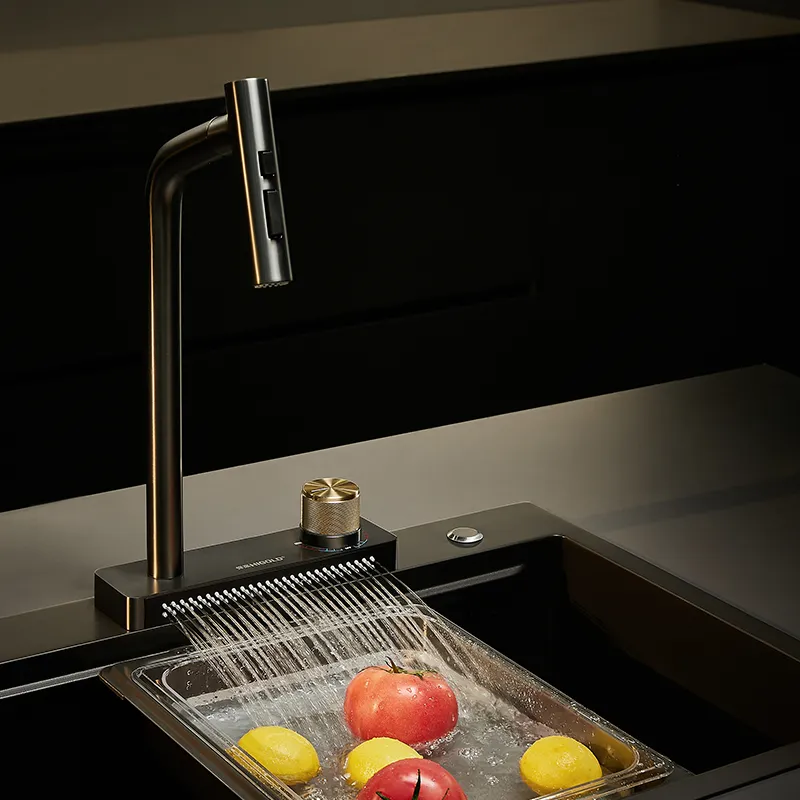
What kind of factory capabilities does Higold have?
Higold is not just a kitchen sink factory — it's a cutting-edge production powerhouse. Covering over 600,000 square meters across multiple production bases including the Hexagon and "Unicorn" bases, Higold is recognized as the largest smart home hardware manufacturing center in Asia.
With over 500 patents and multiple design awards, Higold is the go-to manufacturer for kitchenware buyers seeking advanced production capabilities in China.
